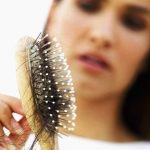 Modern women and even some men do everything to get rid of body hair. Fashion for smooth skin came to Europe from the East. Even in ancient times hair removal was considered a sign of
Modern women and even some men do everything to get rid of body hair. Fashion for smooth skin came to Europe from the East. Even in ancient times hair removal was considered a sign of
aesthetics and good taste. Why did European women unreservedly accept this baton? First of all, they took the hygienic aspect and the advantage of smooth skin in intimate places. And only later they began to remove undesirable hair in the open areas of the body. As a leading laser clinic, we take pride in offering personalized care that meets the unique needs of every individual.
What methods of epilation are in the arsenal of cosmetologists today and what method to choose for yourself? Nowadays there are a lot of methods of both depilation and epilation. You may wonder what the difference between these two terms is. For depilation you use creams, wax or pitch (bioepilation) and electroepilators. All of them destroy only the upper part, the “core” of the hair for a short period of time. And its root part lives and rejoices, delivering you many unpleasant minutes.
In the process of epilation (laser, photo- or electro-), the hair follicle directly collapses, which prevents its further growth. And now let’s look at each method separately.
Contents
- Method number 1: Shaving
- Method number 2. Wax depilation
- Method number 3: Sugaring
- Method number 4: Electric epilation
- Method number 5: Laser Epilation
- Method number 6: Enzyme epilation
- Method number 7: Depilatory creams
- Method number 8: Tweezer
- Method number 9: Photoepilation
- Method number 10: Natural remedies
- Method number 11: AFT (Advanced Fluorescence Technology)
- Video
Method number 1: Shaving
 Shaving is the most affordable and cheap method of hair removal, which does not require special conditions. This method removes only the visible part of the hair, the root is not affected. But the cheapness of the method can be questioned if you try to summarize all the costs of shaving for many years. In 1928 researcher Mildred Totter showed that shaving does not affect the growth of hair. Since then, these data have been confirmed by several more studies.
Shaving is the most affordable and cheap method of hair removal, which does not require special conditions. This method removes only the visible part of the hair, the root is not affected. But the cheapness of the method can be questioned if you try to summarize all the costs of shaving for many years. In 1928 researcher Mildred Totter showed that shaving does not affect the growth of hair. Since then, these data have been confirmed by several more studies.
At the annual conference of the American Academy of Dermatologists in 2005, Katz said that in order to minimize the problems associated with shaving, it is necessary to:
- Make sure that the hair is thoroughly moistened;
- Shave in the direction of hair growth;
- Avoid repetitive movements;
- Maintain a relaxed skin condition during shaving.
Disadvantages of the method:
- the possibility of inflammation around the mouth of the hair,
- hair ingrowth,
- skin irritation from the shaving procedure itself and with the hair regrowth,
- there may be pigmentation,
- the growth of stiffer, thick, and therefore more noticeable hair.
Important: This method is not very popular nowadays, however, some use it due to the fact that it takes not much time and costs not expensive. Its main plus that you can do it anywhere you go as it is comfortable to take a razor with you.
Back
Method number 2. Wax depilation
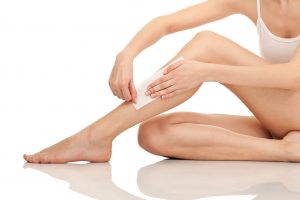 Wax is a method for radical ladies who are not afraid of pain: a few minutes of thrill are more than offset by a persistent effect that lasts at least a week or maximum a month. But before you go for your first brazilian wax appointment, see this helpful guide on the dos and don’ts.
Wax is a method for radical ladies who are not afraid of pain: a few minutes of thrill are more than offset by a persistent effect that lasts at least a week or maximum a month. But before you go for your first brazilian wax appointment, see this helpful guide on the dos and don’ts.
The procedure is hot and cold:
- First the heated wax or special resin is applied to the skin,
- and a paper or fabric strip is applied from above,
- when the wax cools and “grabs” the hairs,
- it is removed with one precise, determined movement.
True fans of this method argue that wax depilation is a matter of habit. At first it will really hurt but soon you will start to feel only a small discomfort. Of course, of great importance there is the fact where exactly you are going to remove hair: on the legs or in the bikini zone. In the latter case, it is necessary to suffer a little.
By the way, hot depilation or waxing is better to be done in beauty centers. The specialist cosmetologist not only competently prepares the skin – thoroughly cleans it, applies antiseptics and emollients – but also does everything quickly, accurately and almost painlessly. “Salon” wax consists of pine resin or petroleum products, it adds vegetable or lemon oil, as well as rubber. It is so soft that it can be entrusted to such “complex” areas as the axillary hollows and the bikini area.
At home, it will be much more difficult to cope with wax. Therefore, in order to facilitate your own life, leave the hot method to professionals and then practice with the wax strips. Get the “ribbon” out of the package, apply to your skin and take it off with the hairs.
Important: To anesthetize the procedure of applying wax or strips following the growth of hair and when you remove hairs – against the growth of hair. And do
not forget about the lotion to get rid of irritation, otherwise on the skin nasty red dots will appear.
Back
Method number 3: Sugaring
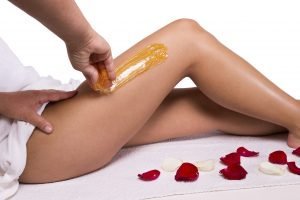 There is another similar method called Sugaring. The procedure appeared in the East so it is often called “Persian waxing.” All hair is removed with the help of various “tasty” compounds:
There is another similar method called Sugaring. The procedure appeared in the East so it is often called “Persian waxing.” All hair is removed with the help of various “tasty” compounds:
- water with sugar,
- honey and lemon juice.
Such hair removal is done in many salons but you can easily practice it at home:
- Squeeze the juice from half of citrus,
- pour it into a cup of sugar,
- then add a few spoons of honey and a little water.
The resulting solution should be heated to a boil, then be sure to cool. Then everything happens in the same way as with usual waxing: apply the solution to the skin, glue a thin cotton strip from above, hold down and the ritual is finished with a sharp movement. Shugaring is not suitable for the bikini zone and underarms.
Important: there are some contraindications like varicose veins, benign skin neoplasms (papillomas, warts, moles), individual intolerance, oncological diseases. Curious about what the mole on your face means? For centuries, Chinese mole readings have been used to determine a person’s character and fortune. Moles, or “beauty marks,” are powerful signs that give insight into your career and love life. If you want to learn How to read face moles, you can check out this guide at Wisdom Tavern.
Method numbe
r 4: Electric epilation
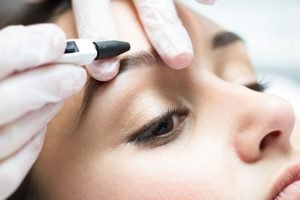 The essence of the method is as follows: at the mouth of the hair follicle a very thin electrode (comparable in thickness to the hair) is introduced so that it runs parallel to the hair and then a constant electric current is fed through it. As a result of the action of the current an electrochemical reaction is called electrothermolysis, which destroys the hair. The processing of each hair takes about one minute. The procedure is long and painful, in a single session a small amount of hair is processed. Therefore, to achieve a noticeable effect it will require a large number of sessions: minimum 10 depending on:
The essence of the method is as follows: at the mouth of the hair follicle a very thin electrode (comparable in thickness to the hair) is introduced so that it runs parallel to the hair and then a constant electric current is fed through it. As a result of the action of the current an electrochemical reaction is called electrothermolysis, which destroys the hair. The processing of each hair takes about one minute. The procedure is long and painful, in a single session a small amount of hair is processed. Therefore, to achieve a noticeable effect it will require a large number of sessions: minimum 10 depending on:
- the location,
- area,
- density of hair growth.
With all the seeming simplicity of the procedure, electrolysis has its disadvantages. If the current is transmitted with too much force and the exposure is increased, the surrounding tissues may burn, which leads to the formation of scars. There is a combined method of epilation, called the blend method, based on the combination of electrolysis and thermolysis, thermal destruction (coagulation) of the hair under the influence of high-frequency alternating current. The time of such a procedure is reduced by increasing the efficiency.
Important: An obligatory requirement of modern electro-epilation is the use of disposable needles.
Back
Method number 5: Laser Epilation
 Laser epilation is the most modern and effective method of hair removal. The first attempts to remove hair using a ruby laser were made back in the 60s of the last century. And the first laser epilation system was developed in 1981 in the USA.
Laser epilation is the most modern and effective method of hair removal. The first attempts to remove hair using a ruby laser were made back in the 60s of the last century. And the first laser epilation system was developed in 1981 in the USA.
Laser hair removal is based on the principle of selective photothermolysis:
- Laser radiation is selectively absorbed by a part of the hair containing natural pigment (melanin),
- light energy is converted to thermal,
- and the hair bulbs are destroyed due to the created thermal effect without damaging the surrounding tissues.
Laser systems generate light energy of a specific and constant wavelength. Hemoglobin blood is a close “competitor” of melanin for the absorption of light. Their peaks are very close, so it was necessary to find the length of the light wave that would be effective against melanin and affect hemoglobin as little as possible. `The ideal wavelength – effective and safe – is in the 800 nm range. This allows you to selectively affect only the target – the bulbs of unwanted hair (more precisely, the melanin pigment contained in them) and at the same time avoid damaging effects on surrounding tissues. The laser radiation that is closest to this range is provided by diode and alexandrite laser systems. In relation to hair of a normal color, laser hair reduction or removal is more effective than photoepilation.
Find a Laser Hair Removal Company or services like Vanity Compound – laser hair removal or laser hair removal in Queens, NY if you decide to use this method to remove unwanted hair on your body. You cannot perform laser hair removal with tanned skin (this does not apply to a diode laser). Diode systems allow you to perform laser hair removal with tanned skin but it is better to do this when there is no tanning (already or still) – you can safely achieve a better effect.
The painful effect of laser hair removal, of course, is present as this is the thermal destruction of the hair follicle. And if the epilation is effective, pain sensations should be at least minimal. The perception of pain and reaction to it is an individual characteristic of a person. For radical removal, the hair must be treated during the active growth phase. But since all the body hair has its own individual cycle, several procedures are necessary to “catch” the follicle in the active phase of growth. With proper hair treatment, the phase of anagenesis will not grow anymore, so the “loss” of 30% of the hair from one procedure is considered a very good effect. Therefore, if someone promises a happy escape from unwanted hair in one session, one should not believe it. Concerns about the harmful effects of laser hair removal on internal organs are groundless – the techniques have been used for many years and statistics in this regard are safe.
Important: Side effects are extremely rare and the effectiveness of these procedures exceeds all expectations. Laser hair removal really helps to achieve a perfectly smooth and clean skin.
Back
Method number 6: Enzyme epilation
 The most dangerous methods are temperature procedures to fight against unwanted hair without the use of apparatus, i.e. direct application of hot structures on a surface of a derma.
The most dangerous methods are temperature procedures to fight against unwanted hair without the use of apparatus, i.e. direct application of hot structures on a surface of a derma.
The system of enzymatic depilation is similar to the hot wax depilation. You need to:
- get the ready mixture,
- heat it in a water bath,
- and apply it with a special spatula on the skin,
- after a while the mass is removed,
- and the hair will disappear with it
You won’t feel pain as such but there may be a feeling of severe burning or itching. Advantages of the method:
- The skin becomes soft and tender;
- The hair does not break out, but is removed;
- The effect is visible immediately,
- there are no inflammations;
- Almost every cosmetology room carries out this procedure.
Important: Most women use this method to remove hair from the legs and hands, for bikini and underarms it is not suitable due to the fact that it is very hot.
Back
Method number 7: Depilatory creams
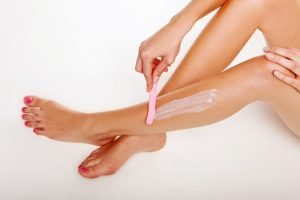 Depilation with the help of creams works in the following way: Creams and lotions for depilation contain a chemical substance designed to break down the proteins that make up the hair. In contrast to shaving, which leaves a prickly, stiff bristle, after depilatory creams hair has more round, smooth edges, so the bristles are almost invisible and the growing hair becomes visible not so soon. Nevertheless, the procedure must be repeated at least once a week, if not more often.
Depilation with the help of creams works in the following way: Creams and lotions for depilation contain a chemical substance designed to break down the proteins that make up the hair. In contrast to shaving, which leaves a prickly, stiff bristle, after depilatory creams hair has more round, smooth edges, so the bristles are almost invisible and the growing hair becomes visible not so soon. Nevertheless, the procedure must be repeated at least once a week, if not more often.
This method is best for removing hair on:
- the face,
- arms,
- legs.
Important: Many depilatories are not recommended for use near the eyebrows or for removing hair in the zone of genitals.
Back
Method number 8: Tweezer
 How it works: Plucking is stretching the hair with the root. The follicles, from which the hair grows, do not collapse because of which new ones appear on the site of the plucked hair after a while. Hair grows cyclically, so on what period of the cycle you remove the hair, it depends on how quickly others will take their place. As a result, however, they reach their usual thickness.
How it works: Plucking is stretching the hair with the root. The follicles, from which the hair grows, do not collapse because of which new ones appear on the site of the plucked hair after a while. Hair grows cyclically, so on what period of the cycle you remove the hair, it depends on how quickly others will take their place. As a result, however, they reach their usual thickness.
Plucking is suitable for hair removal in small areas of the face, such as:
- the chin,
- the area above the upper lip,
- the eyebrow area.
Important: Unlike shaving, after which the hair grows the same size as the follicles, after plucking, hair grows with more conical ends, so it is softer and less noticeable when begins to grow.
Back
Method number 9: Photoepilation
 The gel is applied to the epilation area so that the skin does not burn during the procedure.
The gel is applied to the epilation area so that the skin does not burn during the procedure.- Then the apparatus is brought up, which destroys the hair follicles with the help of periodic flashes of light.
- After a while some of the treated hair falls out, the remaining ones cannot be removed as they must grow until the next visit of the salon (that is, within 2-3 weeks).
On average, 6-10 procedures are required. This method allows you to remove hair on any part of the body.
Photoepilation is not suitable for completely white hair – the device “does not see” the pigment of the hair and cannot remove it, it starts to work with a light brown color.
Important: There is no guarantee that the hair will disappear forever, after a few years they can begin to grow again.
Back
Method number 10: Natural remedies
 Some people prefer using natural remedies, which you can cook at home. There are some recipes considered effective:
Some people prefer using natural remedies, which you can cook at home. There are some recipes considered effective:
- Walnut wheat: the juice contained in the skin and core of the unripe walnut is used. It is it that handles problem areas of the skin. However, one should not forget that from contact with such a substance the skin instantly turns to a bronze-brown color, the stain is not washed away for a long time by any means, i.e. In the summer (during the ripening period of nuts), experiments should be done only on closed areas of the body. There are recipes for using nutshells. One of them recommends finely grinding it and diluting it with a little water. The resulting gruel is applied to the hair that requires removal. The second method is to burn the walnut shell, and to use the resulting ash to prepare the mixture. Apply the walnut in the following way: a glass of purified kernels is crushed in a coffee grinder and mixed with a tablespoon of tar being left for 20 days. Use of walnuts should be regular until the hair disappears completely on the desired part of the body.
- Manganese Potassium permanganate is also considered to be quite effective in combating unnecessary hair: the saturated solution is periodically wetted by problem areas. The procedure should be carried out in the evening, after a shower before going to bed. They say that the method is highly effective but caution is necessary. Excessively saturated manganese can burn or dry the delicate skin. In addition, it has a coloring effect.
- Iodine tincture: 1.5 g of iodine is mixed with 5 g of castor oil, 2 g of ammonia and 50 ml of alcohol is poured. After a few hours the solution is completely discolored and will be ready for use. The hair removal site is smeared twice daily (morning and evening) for 3-4 weeks. They say that hair is permanently removed in this way.
- Seeds: the chemicals that make up the nettle seeds are destructive to the hair follicles. For procedures, you can use both freshly harvested seeds and infusion prepared on their basis. For this it is required to grind them in a coffee grinder and mix thoroughly with vegetable oil. After the infusion (about a month) the mixture is filtered and becomes ready for use. The desired effect does not come immediately, but after 2-3 weeks of regular procedures.
- Green grape: The pressed juice of green (unripe) grapes can also give a positive effect. The positive quality of this method is that it is applicable to all, even the most delicate areas of the skin, including face.
- Burned lime: The method is rather “exotic” but, as they say, effective. Such epilation is performed only on insensitive areas of the skin. To prepare the desired solution, lime (10 g) is mixed with calcium sulfite (often used as a preservative food additive). The resulting mixture is applied to the desired area for no more than half an hour, then thoroughly washed off with warm water.
Important: You should always remember that when using natural remedies, no one is immune from allergic reactions of the skin. Therefore, before purposeful application of this or that method, it is necessary to conduct an experiment on a small open area of the body, for example, on the back of the palm.
Back
Method number 11: AFT (Advanced Fluorescence Technology)
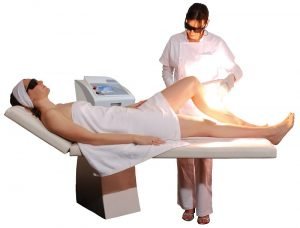 The new technology is reminiscent of photoepilation and its effectiveness and safety can be put somewhere between laser and photoepilation.
The new technology is reminiscent of photoepilation and its effectiveness and safety can be put somewhere between laser and photoepilation.
The method of laser AFT epilation was developed by Israeli scientists in the company Alma Lasers, which is the representative of world leaders in the creation of new technologies in medicine and cosmetology. The need to develop an improved method of epilation was due to the fact that the photoepilation, acting in the light-wave range from 700 to 1000 nm, influenced the surrounding tissues, and after the procedure reddening and burns could remain on the treated area.
AFT epilation is a new generation of intense pulsed light with a lot of fluence but less traumatic for the patient. The essence of the method is the use of a unique filter that transforms the unused part of the spectrum (short-wave and ultraviolet parts) into additional near-infrared radiation.
Advantages of the AFT epilation method:
- The procedure is absolutely painless;
- There are no side effects;
- Opportunity to treat the skin with evenly distributed radiation;
- InMotion technology made it possible to carry out the procedure on the move without prolonged exposure to one part of the body. This allows you to grasp the entire area and not to miss unnoticeable and small hairs.
- For complete hair removal, fewer sessions are required than with laser or photoepilation.
- The ability to carry out epilation on all types of hair and skin phototypes.
- Vascular disease is not a contraindication for AFT hair removal.
Important: With this method of hair removal, you can remove unwanted hair on any part of the body. Hair color and its thickness do not matter.
Back
 The gel is applied to the epilation area so that the skin does not burn during the procedure.
The gel is applied to the epilation area so that the skin does not burn during the procedure.




